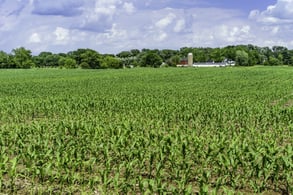With pandemic coping strategies on the minds of everyone, including farmers, it can be easy to lose sight of important principles related to soil management and best practices for ensuring your farm and farmland are producing at their best. Additionally, when farm incomes are lower than normal, some conservation or sustainable practices may go by the wayside.
Regenerative agriculture, a system of soil and water management practices that benefit the entire ecosystem, is drawing attention in the farming community. Regenerative agriculture's holistic farming principles enhance bio- and soil diversity and sustain and improve watersheds. Regenerative growing practices also aim to capture biomass and carbon above the soil and bring them back to the soil, thereby reversing the global trend of releasing carbon into the atmosphere.
Core benefits of these practices include increasing soil health through increased amounts of organic matter, building crop resilience due to enhanced water holding capacity, increasing the nutrient density of a variety of crops, and increasing biodiversity both above and below the soil. Below, we describe some of these benefits in greater detail.
Sustain and nourish the soil
One key benefit of regenerative agriculture is carbon sequestration, which allows a farmer to sequester carbon deeper in the soil. This, in turn, benefits soil health and crops. Capturing more carbon also involves drawing carbon from the atmosphere via crop growth, offsetting its damaging effects on the air and environment.
Proponents of regenerative agriculture also point to the fact that it minimizes or eliminates the need to till the soil, along with reducing the need for chemicals and fertilizers that use salt, thereby improving the environment. Tilling breaks up soil and beneficial fungus growth and incorporates more oxygen into the soil, leading to more water runoff and soil loss.
Promote biodiversity for healthier farmland
Several regenerative agriculture practices that promote soil health are probably familiar to you and are gaining favor in the farming community.
One of these - introducing cover crops - benefits the soil and can introduce other sources of income for your farm. Cover crops are planted between other crops, typically row crops. Multi-cropping and inter-cropping practices not only promote farm diversity but also sustain the long-term health of your primary crops. The soil sequesters more carbon, increases organic matter and does not erode due to cover crops. Healthier soil with a wider array of bio-nutrients creates operating value and long-term capital value for your farm.
Increase climate stability
In many parts of the country, farmers have had to deal with extreme drought and wet weather cycles. Protracted  periods of rain can have a negative effect on crop yield and can wash away soil. Regenerative farming practices that increase biodiversity and carbon in the soil will mitigate the effects of tilling and soil compaction, which reduces runoff and preserves the soil.
periods of rain can have a negative effect on crop yield and can wash away soil. Regenerative farming practices that increase biodiversity and carbon in the soil will mitigate the effects of tilling and soil compaction, which reduces runoff and preserves the soil.
Even giant agribusiness companies like General Mills are taking the lead in educating growers about the benefits of regenerative agriculture. Other research on regenerative agriculture focuses on its benefits for the climate, including sequestering carbon emissions and lessening the severity of rainfall and heat.
Halderman Real Estate and Farm Management want to ensure that you're kept up to date on the best practices that can help you maintain the health of your soil and your farm. We look forward to working with you during these difficult times and positioning you to keep your farm running at its best.






